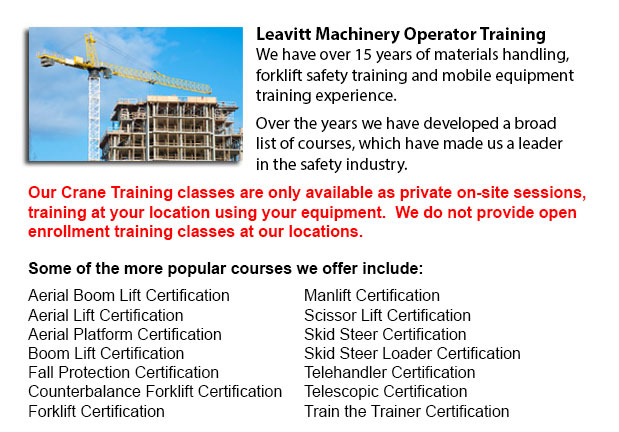
Markham Overhead Crane Safety Training - Overhead crane safety training equips operators with skills and knowledge about crane safety precautions, accident avoidance, materials handling, and equipment and stock protection. Trainees will learn the types of overhead cranes, their capabilities and their uses in various industry settings. For operators who are licensed and trained, the shift in liability moves from the company to the operator. Hence, the course emphasizes individual operator tasks.
Overhead crane safety training instructs operators in the right techniques for doing inspections. Two kinds of pre-shift check are the in-depth inspection and the walk-around inspection. These are important daily routines which should be logged. Properly recorded pre-shift checks help to protect the business from liability in the event of an accident. Pre-shift checks likewise prevent damage, costly repairs and accidents. Operators learn how to designate a specific individual to carry out checks, how to maintain the log book and how to report problems.
Each and every inspection should be carried out and documented regularly. Things that must be checked for possible concerns, consist of: hooks for cracks, increases in the throat opening, degree of twist; hoist ropes for corrosion, worn wires, loss of diameter, bird caging and kinks, broken wires, chains for nicks and gouges, chemical and heat damage, cracks and corrosion, twists, distortion, excessive wear, pits, stretching, damage caused by extreme heat.
Operators learn proper rigging measures in this program. Rigging involves understanding the manufacturer's data plate, determining the material weight to be lifted, choosing the gear, and using safe practices to secure the load. The course include in detail the following: safe working loads, and the capacities of ropes, chains, hooks, shackles and slings.
It is essential to understand who may use the cranes at your facility, physical requirements of the job, and operator credentials required for permits and specialized job. Safety is a top priority when using near pedestrian traffic.
The responsibilities involved in the safe crane utilization consists of undertaking visual inspections, checking for hydraulic leaks, checking the safety guards, testing the controls, examining the hoist rope and hook, braking mechanisms and limit switches. Proper reporting methods are critical. These subject matters are all included in depth in the program.
The course likewise covers the proper lifting and moving procedures with hoists and cranes. Operators would likewise learn right hand signals. Training involves how to attach the load, raise the load, unhook the slings, abort a lift and set the load.
The steps involved with moving the load, consists of: stopping and starting procedures, guiding and controlling the load, working with signals and observing working conditions. In the event of power failures, the operator will need to know how to proceed. The program covers techniques for lowering the load and removing the slings, storage of equipment, parking the crane, and securing an outdoor and indoor crane.
-
Markham Forklift Certification Schools
Markham Forklift Certification Schools - Forklift Certification is mandatory in North America. Hence, forklift training programs are essential both for businesses and for people seeking jobs in industries as forklift operators. Forklift training focu... More -
Telehandler Training in Markham
Telescopic handlers normally called telehandlers for short, are a very popular piece of heavy construction equipment. They are commonly utilized in the construction and agricultural trades. These machines have maximum reaching capability and can get... More -
Markham Zoom Boom Training
Markham Zoom Boom Training - Zoom Boom Training is designed to train operators on variable reach forklifts. The objectives of the training are to impart an understanding of the physics of the machinery, and to outline the operator's tasks. This progr... More -
Markham Heavy Equipment Ticket
Markham Heavy Equipment Ticket - A heavy equipment operator will utilize different construction machinery, depending upon the nature of the task at hand. The large equipment are constructed to carry out specific tasks in the most efficient method for... More -
Markham Scissor Lift Training
Markham Scissor Lift Training - When operating a scissor lift, they must be utilized competently so as to protect the safety of the other employees inside the workplace and to protect the safety of the machine. Competent operators are trained to driv... More -
Markham Manlift Operator Training
Markham Manlift Operator Training - The aerial lift or manlift is a specialized kind of hydraulic platform which is designed to raise a person vertically giving it an alternate name of a vertical personnel lift. These machines are widely used for a m... More -
Markham Heavy Equipment Training
Markham Heavy Equipment Training - The two most common kinds of heavy equipment training are classed into the categories of machinery; equipment that is fashioned with tracks and those with rubber tires. The tracked vehicle are heavy duty equipment s... More -
Markham Forklift Safety Training
Markham Forklift Safety Training - Those wanting work in industries that utilize forklifts should undergo a forklift safety training course before becoming a certified operator of a forklift. There are various ways to go about getting forklift safety... More

Forklift Certification Markham
TOLL FREE: 1-888-254-6157
Markham, Ontario
forkliftcertificationmarkham.com
Email Us
About Us


